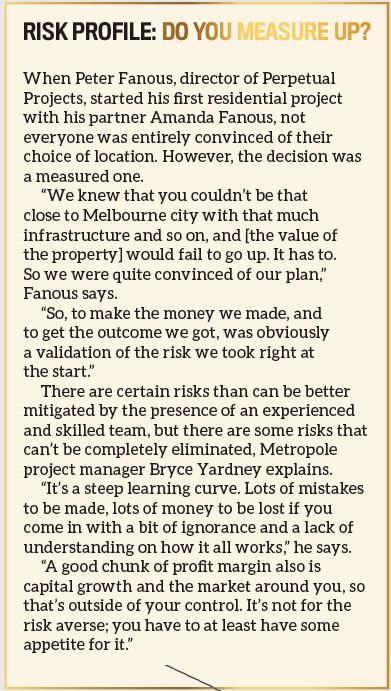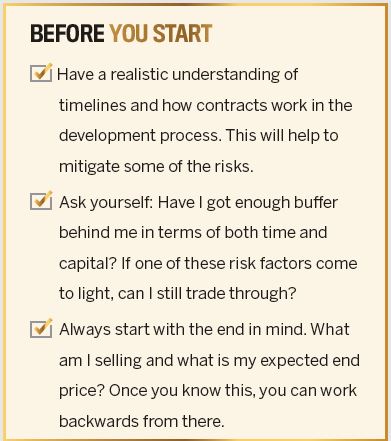BRYCE YARDNEY, project manager at Metropole Projects, says the best place to start is by leveraging off of “people who have been there and done [development projects] and have been around for a little while”.
“People like to throw around big numbers, big profit margins, but they are not always realistic, especially for beginner investors, so be careful who you listen to,” Yardney says.
“I think a good place to start for development or property in general, maybe even a step before you get into development, is with something small like a renovation, from an apartment to a townhouse to a villa unit – something where you can learn the ropes.”
Yardney says this is an ideal platform from which to begin to understand the dynamics around development and the experts that are involved in it.
“I think getting into a development first before you have done anything else is really diving into the deep end. Get your feet wet a little bit on something smaller, where you have less to mess up, less money to lose and still a lot to learn,” Yardney says.
Brendan Kelly, director of Results Mentoring, breaks down a possible entry point.
“Developing is the process of construction and subdivision,” he says. “So an ideal beginner project is to buy an unrenovated house on a large block of land, cosmetically renovate the house, subdivide the land into two, and build [a second house] on the back.”
“The more houses you build, the more profit you are entitled to as a margin"
For a one-into-two build, which involves demolishing an existing house, a minimum 12% profit on total costs would be in the pipeline, with a maximum potiential profit of 15%, Kelly says.
“Margins could be a little bigger with the right market conditions,” he adds.
For a one-into-three build, he says the minimum profit on total costs would start at 12% and could be extended to 18% – “if the planets align”.
“The more houses you build, the more profit you are entitled to as a margin,” Kelly says.
Building a house at the rear of an existing property, known as a battle-axe block, has more universal application, Kelly says, “because you are not destroying an asset to build an asset”.
By renovating the already established property, a beginner can be introduced to the major concepts of construction.
“You get to know how houses are built. You get to talk to trades, you get to talk to all the people, you get to introduce yourself to how houses are put together, and they become less scary,” Kelly says.
However, with the context of each project being shaped by a multitude of varying factors, Kelly says proceeding depends on the numbers.
“If the numbers demonstrate a profit, the project can be undertaken with some confidence,” he says.
Damien Lee, Caifu Property’s head of acquisitions, suggests that a house and land project can also work as a great starting point for the first-timer. It helps the investor begin to understand the work involved in purchasing a block of land and gaining council approval, as well as securing financing, he explains.
“If you are a beginner developer and you are able to associate yourself with a team that has leverage in all of those categories – including experts from legal to financing, town planning and construction, as well as acquisitions – you can probably bite off a few more sites based on whether you have a very good team around you that are controlling and guiding you through the process,” Lee says.
However, he recommends that someone without a deeply experienced support group should focus on a single project and see it through to completion.
Using market data, comparable sales and mortgage security evaluations, Caifu Property demonstrates to its clients how they could gain at least a 10% return on total development costs for a house and land package.
As an example, Lee says, for a house package that cost $500k, the developer could expect a profit of up to $50,000.
Are your finances fit enough?
According to Byrce Yardney, project manager at Metropole Projects, for a small duplex development an investor would need to have 25% of the total project costs in equity. So, if costs came in at $1m, then $250k in equity would be required prior to starting.
“The vast majority of duplex developments in Australia would be more than that,” he adds.
“The worst thing you can do is get stuck halfway, because it messes up your numbers; you haven’t allowed for enough contingency – so you need to have enough money to get you through, plus a buffer just in case.”
He recommends getting the advice of a finance strategist who is well versed with the cash fl ow requirements of developments.
“Things will go wrong, especially in your fi rst one or two projects … It will take longer than you expected, and it will cost more than you expected, so allow for that buffer, allow [for] the contingency.”
Kelly adds: “Cash flow is king. You have got to do your numbers before buying the property in order to know that you have the money to see the project through to completion. The amount of cash you are likely to need for a one-into-three development, for example, represents about half the value of the purchase price of the block you are building on.”
Moving with the market

He believes there is plenty of scope for investors to enjoy solid profi ts as developers, but it’s essential to do extensive due diligence from the outset.
“You have to start somewhere where, for example, you can buy the cheapest house in that suburb and build it up from there,” he says.
“Your research might show that the ceiling in that suburb, for example, is $800k – and you bought a house for $600k, because it’s in very bad condition, so you know that it can potentially go up by $200k.”
Securing the right site is crucial to your success, says Lee.
“If you don’t have control of your site yet and you are waiting for that to be developed by a land developer next year, and it doesn’t register until March next year, well, there are a lot of things that can change that are out of your control between now and March next year,” he says.
Going ‘unconditional’ on a block of land involves a non-refundable 10% deposit being placed with the land developer, Lee explains, and if a person’s circumstances change when it comes to settling the land purchase, they may be at risk of not being able to obtain the financing for it.
‘Registered’ land allotments, on the other hand, allow for more financial control from the start, he says.
Time is of the essence, yet running a development project to schedule can quickly present hurdles. According to Kelly, holding costs can be one such problem, which can be avoided by engaging a construction team that is not only reliable but punctual.
“You are servicing debt on the land and on the construction while it’s underway. The longer you hold it without income, the more it erodes profit,” he says.
Getting the green light from council
The process that often comes with gaining the seal of approval from council authorities can also impede progress with your project, which is why Yardney considers it valuable for a town planner and project manager to be on board.
“Different councils can be drastically different, even if they are right next to each other,” Yardney says.
“So it’s useful to have someone as part of your team that knows them, understands them, has worked with them many times and, most importantly, has relationships inside that council, because that can count for more than anything.”
However, even when someone thinks that they have delivered all the required documentation for approval, Kelly says it can still be common to experience delays.
“As a guide, whatever time you think it will take to get through council, double it,” he says.
“We do not want to be pioneers. We want to go where other people are already building what we want to build, because we don’t want to be the one to set a new benchmark in either design or price … You don’t want to have to fight council, or the market, in order to walk away with cash in your pocket, particularly not for such a small development.”
This is where paying a town planner or project manager can be worth its weight in gold, although Fanous says each person’s individual approach should be shaped by their profession, their already-learned skills, and their emotional intelligence.
“You’re going to deal with a lot of people throughout this whole process,” he says.
“Although your designer is a very important part of the process, there are so many other things that feed into that designer. So [you need to be] able to choose things at the right price from the right consultants, and also have a bit of a technical know-how.”
“You do not want to be pioneers ... you don’t want to have to fight council, or the market, in order to walk away with cash in your pocket”
It’s also essential to budget correctly, ensuring that the project measures up to its initially confirmed cost. And it’s just as important to employ the services of a skilled and experienced team of professionals.
Working alongside a qualified and skilled draftsperson or architect, a land surveyor to execute the subdivision and a builder for the construction will help minimise the risks.
Yardney encourages the beginner to start with “something simple that you can wrap your head around”.
“If you want to dive into something bigger, and there is nothing wrong with that, you have to have the right team around you – people who have the knowledge and expertise that you don’t, so that you can manage the risks and not try to do it yourself,” he says.
In addition to a solicitor for the conveyancing, and an accountant for the business structure, Yardney recommends building good relationships with real estate agents so that opportune sites, which can sometimes sell off the market, can be discovered.

